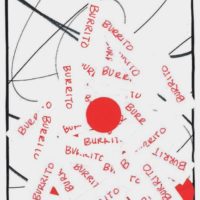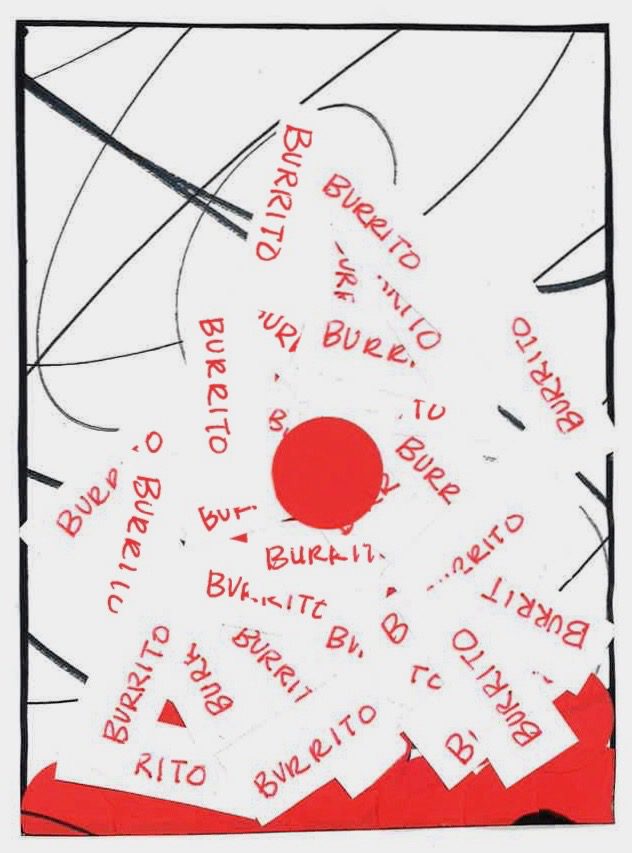When I was hungry and broke, I’d steal frozen burritos from grocery stores. They never caught me as stealing the burritos (or for that matter, anything else) required patience and really good mentors—namely, my cousin and his two friends who, collectively, called themselves the Shrimp Bandits.
The Shrimp Bandits were in their late teens when they terrorized the frozen sections of grocery stores across El Paso, Texas. They’d developed a simple scheme for stealing frozen shrimp. At first, it was just two of them; to protect the guilty, we’ll call them Shrimp Bandits 1 and 2. They’d simply walk into a grocery store, grab bags of frozen shrimp—always the large, thirty-one to forty count bag that’s already cooked, peeled, and deveined—and run out as fast as possible, hoping to find safety by hiding between nearby houses. After a few close calls, their technique evolved.
They incorporated a getaway driver who’d leave the car running near the front of the store. He’d stand close, pretending to unload an empty propane tank. While he did that, the two original Shrimp Bandits entered the store. Shrimp Bandit 1, who was the fastest, took the shrimp and ran out while Shrimp Bandit 2, the fatter of the pair, stood near a red DVD-rental kiosk. His job, aside from whistling to the getaway driver to signal Shrimp Bandit 1 was on the run, was to interfere if someone gave chase. If security or a worker ran after Shrimp Bandit 1, then Shrimp Bandit 2 would get in their way, allowing Shrimp Bandit 1 an extra few seconds to jump into the getaway car. They’d always leave Shrimp Bandit 2 behind and eventually meet at a prearranged place where the three would split the take. There was no money—there never was—just frozen shrimp.
Authorities never caught the Shrimp Bandits. Just as suddenly as they appeared, they disappeared. The Shrimp Bandits didn’t stop stealing because of a sudden change of conscience or moving on to stealing something of higher value. Rather, each of their mothers—who likely asked once or twice where all the shrimp came from before they just quietly ignored it—told them to stop bringing home so much shrimp. They stopped stealing because their moms ran out of freezer space.
At the height of their banditry, I saw five perfectly stocked refrigerators full of bags of frozen shrimp. Since there was no black market for shrimp, at least not in El Paso, the bandits and their mothers got stuck with the product. They also couldn’t move it in Juárez—El Paso’s sister city across the border—since their price for shrimp was already cheap. Plus, the long lines to cross into Mexico resulted in the shrimp thawing out before they could sell it. No one is crazy enough to buy warm shrimp in a bag. Had the bandits packed a cooler full of frozen shrimp, the Mexican police, which inspected incoming cars, would inevitably demand a kick-back that’d further bite into any money made.
Since few risked buying what was, in essence, second-hand shellfish, the Shrimp Bandits resorted to giving away what they stole. For a few months around the summer of 2005—I remember this well because, as a way of settling their nerves, they listened to Jay-Z’s “Dear Summer” after each successful heist—within a five-mile radius in east El Paso, it became common street knowledge that if you wanted free shrimp all you had to do was know where to ask. All you had to do was knock on the garage of a yellow house on the corners of Diego Rivera and Manuel Acosta Drive—fitting street names for the Shrimp Bandits who once, while high, told me they saw their shrimp stealing plan, and execution of it, as artistry.
I first heard about the Shrimp Bandits’s exploits directly from them. Like many low-level thieves of limited intelligence, they were eager to tell their story. I didn’t believe it so I begged to see it firsthand. It didn’t take much to convince them and I was there for several of their shrimp runs, standing by a payphone that had been demoted to a late-night bathroom spot. From there, I saw everything: a clear sight line to the back of the store, where the frozen section was. To my right was the red DVD-rental kiosk, and all I had to do was turn around to see the getaway driver pretending to be refilling his propane tank.
After seeing it all in action, I realized three things. First, they were serious. Second, they weren’t artists. And third, related to the previous note, their methods were seriously flawed, which, in my view, would’ve eventually gotten them caught. These were the flaws I learned from when I stole frozen burritos.
If you ask me why I did it, I can’t give you a proper answer. I was hungry and didn’t have much money, but it wasn’t like I was homeless or went to sleep starving.
Perhaps I felt some type of Mexican, working-class nihilism. My mother and father moved to the United States to give me opportunities they never had. There’s a burden there, especially when you are remarkably average and silently haunted by voices whispering, “You haven’t done enough to justify others’ sacrifices. You should be more than this.”
In the world I came from, doctors and lawyers born from immigrant families were the exception rather than the rule. As a matter of fact, I didn’t know any doctors or lawyers in the immigrant families I grew up with. The feel-good stories featured on television made me feel like shit. It must be nice to be educated, I’d think to myself, feeling resentment at the pit of my stomach.
With no practical knowledge of the complicated mechanisms for obtaining a higher education, people like me just fell through all those cracks the lie between daydreams, unrealistic expectations, and sensible goals. Sometimes people like me end up working, quite literally, alongside our fathers. The American Dream gets reduced to learning how to speak English without an obvious accent—measuring success by how little translation is required when watching crime and action movies.
So, as far as stealing frozen shrimp or burritos is concerned, well, it felt like affirming a certain level of intelligence. Not books smarts but a mixture of street smarts and bravado, both always held at a premium when one lives in a place—both physically and mentally—that’s otherwise forgettable and lacking a sense of power.
Or maybe that’s just an excuse for why I stole frozen burritos.
The first thing I realized was that of all the frozen items to steal, frozen shrimp may have been the worse choice, save for frozen pizzas. But even pizzas are eaten with greater frequency than shrimp. Eating shrimp was expensive and thus, a rarity. And, at least for those of us who lived in the Chihuahuan Desert, shrimp denoted a level of class—one can’t eat them while wearing sweats without feeling out of place. It’s almost disrespectful to do so.
Frozen burritos, however, were as far removed from the upper class as one could get. Some Mexicans would not even consider fresh burritos to be authentic Mexican food—whatever that means. So, in a sense, a frozen burrito, made in bulk and shipped with labels and names to denote some sort of cultural affiliation (there are never any wrappers saying Connor, Tanner, or Dustin’s Burritos), was a bastardization of food that already lacked a father.
In terms of practicality, frozen burritos were perfect to steal. Unlike the shrimp bags which were bulky and had lots of empty space within them, frozen burritos come in compact wrappers. And like pizza, but easier to steal, there’s an ease in eating burritos that make them a much more convenient choice.
Anyone could eat frozen burritos anywhere, while wearing anything, while doing whatever. Since I was hungry, it mattered little that I found frozen burritos disgusting. Their flavor and texture of unevenly heated canned beans made worse by knowing Juárez—where according to some, was where burritos originated—had the cheapest and best-tasting burritos anyone’s ever had. But I didn’t have time to go to Juárez, plus stealing fresh, delicious food felt more like a crime than taking what passed as burritos from some faceless, billion-dollar conglomerate.
I also realized that one just can’t just go into a store and begin pocketing things; that’s reckless and a sure way of getting caught—which almost happened to the Shrimp Bandits on several occasions. Instead, I planned obsessively, considered all potential variables.
Among the most important lessons is recognizing differences: which cameras see different angles, which cameras weren’t even turned on, and which objects were in fact cameras though they didn’t appear to be. There’s also a huge difference between cameras and security, and while most stores have the former, they don’t equate to being the latter. Also, though I never tested it, I assumed there’s a difference in reaction between stealing from a store that’s family-owned and operated and taking from a national grocery store. It was easy to imagine that someone who owned a store and set their own rules was much more likely to use force than an employee of a major corporation, who may be disgruntled with their pay and hours, might be. But by far the most important difference was knowing the surrounding areas of stores. This knowledge informs everything.
The surrounding area of a store is the greatest indicator of its level of concern regarding stealing. The more affluent the area, the less security they’ll have. If the area is not only affluent but has a high number of retirees, they might as well have a sign advertising how easy they are to steal from. Meanwhile, grocery stores in lower socioeconomic areas can have multiple security guards on duty at a time. To keep it simple, I kept away from grocery stores that catered to the Latino population. These stores usually had a Western Union, jewelry store, and/or check cashing stores that charged inordinate amounts of interest on payday loans. Each of these added to the raw cash coming in and out of the store, which translated to an increased security presence.
In El Paso, where over eighty percent of the population is Hispanic, discerning which store caters to which ethnicity isn’t easy. Had I kept stealing frozen burritos when I moved to Dallas, this difference would have been much clearer. So again, for the sake of simplicity, in El Paso, I targeted grocery stores where people were much more likely to speak English over Spanish. Stores in areas where they saw outsiders as Mexican rather than Mexican American. But stealing from grocery stores in the upper-class part the city meant I had to be careful to not stand out. The first time I stepped into one of these stores—not to steal, just to case the place—I was genuinely taken aback by its differences from stores in working-class neighborhoods. Everything appeared and felt different.
Unlike the light-colored, drab floors with florescent lighting I was used to, the flooring and ceilings in these stores were of a darker color, which, when combined with the drop-down lighting, gave a more modern feel. Most of their produce was several days away from being ripe, unlike the produce found in stores I shopped in which had to be consumed within a day or two after purchase. These stores didn’t have that smell, which is probably a mixture of dried blood from the meat section, overripe produce, and industrial cleaning products. Most surprisingly, these stores had large red coolers next to the freshly baked French bread. Inside were stacks of freshly made tortillas from a tortilleria right down the street from where I lived.
I was angry. Not only angry at how much better the upper-class ate, but that they could eat authentically—for lack of a better word—with little effort or risk of having to travel outside of their comfort zone. But I took comfort in knowing I’d soon be eating for free, and felt satisfied that the storees wouldn’t even know anything had happened.
It seemed the Shrimp Bandits robbed during any time of the day, mostly when they were bored. Unlike them, I figured between 5:30 a.m. and 9 a.m. was the sweet spot. Anything earlier and employees might have thought I’d been up all night. Anything later and they’d think I was unemployed. Both increased the likelihood of me being viewed with suspicion. I also dressed for the role, which meant as plainly as possible. I wore nothing memorable that could have stood out or offered an identifying marker. Not wanting to draw attention, I kept away from bright colors and never wore shorts or sandals. This was also for practical reasons—shorts had little holding room and sandals were a tripping hazard. Instead, I wore high socks (picture the basketball player, Jason Terry) covered by boot-cut, relaxed fit jeans.
As I dressed before each frozen burrito caper, I made sure my socks still held their elasticity. I ran in place while wearing them, all to make sure they didn’t sag and defeat their purpose. They were thick, green, and stretched to just below my knee cap. They were Army-issued and given to me by my father. Once satisfied with the socks, I’d take my hand and inspect the inside of my sneakers—high-top black Chuck Taylors—checking for anything that might slow me down. I’d flip the shoes and remove anything from their bottoms. Little pebbles caught between the ridge patterns can easily cause one to slip on hard floors. Once all of this was complete, I’d carefully put my shoes on, slowly so the sock wouldn’t jumble around the toes and heel.
I once heard that the first thing legendary UCLA basketball coach John Wooden taught his players was how to properly put on their socks and shoes. Any wrinkle in the socks or loose flap inside the shoes could cause blisters. I always thought of that story when I put on my socks and shoes before I double-knotted the laces and made sure my belt held my pants firmly in place.
I never took frozen burritos from a local store. The Shrimp Bandits did this all the time and therefore, couldn’t return to buy a simple tomato without feeling they were being watched. Stealing from a local store also increased the likelihood of seeing someone you know. And when every second counts, someone stopping you for a quick “hello” can make all the difference.
After I picked a store, I studied the parking lot: which exits led to where, which entrances were most busy, and whether the back of the store was an enclosure. Since I was a one-man operation, I parked as far away from the store as possible, closest to the exit I’d be driving through. To park at a distance sounds counterintuitive, but I knew that if I were being chased, I could use my athleticism to my advantage by putting distance between myself and the chaser. Had I parked as close to the store as possible, I would’ve negated that advantage. So, I parked away from the building—and pedestrians—leaving the car door unlocked while, one last time, making sure my socks were pulled up, my shoes tied, and pants secured.
Of all the memorable things during my exploits as a frozen burrito thief, a feeling I’ll never forget is that of the ice-cold air conditioning hitting my body as I entered the store. The juxtaposition of the hot, summer mornings of the El Paso-Juárez borderlands and the air conditioning power of these stores couldn’t have been more glaring. The grocery stores I was used to had a dampness to them—a swamp cooler effect that could make the indoors feel more uncomfortable than being outside. In the grocery stores in my neighborhood, a subtle sweat on your covered chest and thighs would develop, made worse by the floor’s stickiness and the subsequent sounds of queeek, queeek coming from your shoes with each step you took.
Conversely, these fancier grocery stores had an icy feeling to them. Refrigerated air conditioning, powerful to the point one could feel it ten feet before walking through the front doors. It felt so relaxing that if I could replicate a feeling, I’d want to feel that relief of walking from the hot outdoors into the wintry wonderland of those grocery stores.
Once inside and in front of the freezers, I’d patiently look around and even check out prices. The point was to get the most expensive frozen burritos available. This I’d learned from watching the Shrimp Bandits, who always chose to steal the most expensive shrimp. Why settle for only $.79 bean and cheese flavors when you can have the best for free? I’d get something with protein, something with chicken and meat. But always, always, always, I’d also get two of the cheap bean and cheese burritos.
With frozen burritos in hand, I could have run and likely gotten away but there were only a few upper-class grocery stores in El Paso. Had I run out of each one of them, they’d soon recognize me and the entire scheme would have to end. I didn’t just want to eat for one day; I wanted to feed myself for a lifetime. So instead of grabbing and running, I kneeled, pretending to tie my shoe—shielding the inside my leg with the opposite shoulder—and slid the burrito under my pant leg and into my socks. I placed them on the front and back of my calves but never the sides. Most people will see you either from the front or back and the bulk in your lower legs will blend in. But if the frozen burritos are on the side of your calves, it’ll look awkward.
I eventually grew comfortable with multiple cold burrito wrappers pressed against my lower leg. I also learned to alter my walk, just slightly, to decrease the noise made with each step I took. Few things invite suspicion as walking in and out of a store empty-handed. So, to appear less guilty, I’d pay for the two $.79 burritos. The total was always $1.71—less than $2 for ten frozen burritos if you counted the other eight I had stuffed in my socks. Each shin had two, vertically placed and on top of one another but not stacked. Two more against each calf. All eight held in place by socks that tightly hugged me below the knee.
Relax. Don’t look around. Say “hello.” Smile, but not too much. Take the change. Say thank you. Leave.
Every time I walked out of the store, car keys in hand and frozen burritos burning cold against my legs, I felt a slight jolt. This was adrenaline that, since I wasn’t burning it off by sprinting out of the store like the Shrimp Bandits had done, I had to restrain. I also had to quiet the inner voices telling me to look over my shoulder and see police chasing me. I had to convince myself there were no police coming after me. Fighting the urge to look back was one of the most difficult things I’ve ever done. So much of stealing frozen burritos is having the nerve to pull it off, to appear as calm as possible during a moment when your mind is a rough storm.
From my car to the grocery store and back to thee car, it’s almost as if I was two people: one going through the motions and another on the outside, looking down at everything.
The thing about stealing frozen burritos and not getting caught, is that you, almost inevitably, begin to wonder what other things you can take. You begin to justify your actions, daydreaming that if caught and given the opportunity to tell your story, you’d become something close to a folk hero. I began to dream that people, like me, would understand completely why I did what I did. That, even though I never gave to others from my spoils, I’d become some sort of grocery-store Robin Hood—my own version of Pancho Villa, simply by taking something from a corporation so rich they’d never even notice it was gone. Corporations too fancy to even consider setting up shop in our neighborhoods.
But since I stopped with the frozen burritos heists before getting caught, there’s no potential for such sympathy. Rather, telling my story now, devoid of an actual antagonist, I’m reduced to nothing more than an idiot who, for about six months in my early twenties, ate mostly frozen shrimp and burritos.
***
Rumpus original art by Leesa Travis.








